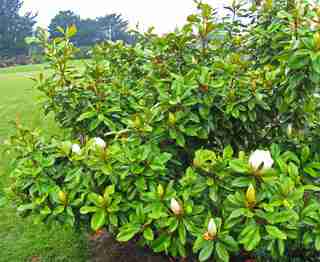Say “magnolia” and most people envision large shade trees with fragrant blossoms that evoke the American south. True, some grow as big as 70 feet, but with 12 species and hundreds of varieties, including ones that flourish as far north as Maine and Minnesota, there’s a magnolia for everyone. “Think of magnolias as you do fashion—there’s a size, shape, style, and color suited to the decor of just about any garden, even the smallest ,” says Judie Evrard Brower of Tesselaar Plants , an international plant research company. “Some can even be container-grown.” And don’t think for a moment that they’re fragile. “Magnolias are easy to care for and disease-resistant,” Brower says. They’re also versatile—they can grow as a hedge or be trained to climb up a lattice against a wall. Here, you’ll find a few popular choices worth exploring, plus Brower’s guidance on how to incorporate them into your outdoor space.

Major impact in small spaces With its rounded form and diminutive size—only ten to 12 feet tall at maturity—the aptly named Baby Grand is great for smaller gardens . “The leaves resemble a rubber plant, dark green and glossy, which brings interesting texture when not in bloom,” Brower notes. Reaching maturity in ten to 12 years, the Baby Grand can be espaliered or shaped as a topiary. Although bushy, the bottom branches can be trimmed off to achieve the look of a small tree.

Perfect for privacy Thanks to its compact growth and evergreen foliage, the Fairy Magnolia makes a handsome hedge that can rise as high as 12 feet in as few as seven years. “Plant the trees three feet apart for a dense screen, or five feet apart for a looser look,” Brower says. And talk about blossoms: Unlike other magnolias, the Fairy was bred to have at least one, sometimes two buds on each leaf axil. “So when in bloom they’re really loaded,” Brower says.

Best for a bold statement The Felix Magnolia reaches a mature height of 16 feet, and its blossoms are huge—12 inches across, the size of a dinner plate—and that fuchsia hue couldn’t be showier. “If you want big, bright blooms to cheer you up in early spring, this is the way to go,” Brower says of the Felix, which responds well in cooler weather. Its pyramidal shape and upright structure, without much shrubbery at the bottom, make it conducive to an underplanting of spring bulbs.
Delicate appearance yet robust With elegantly tapered petals and a maximum width of four feet, the Burgundy Star Magnolia looks fragile, but it’s quite hardy. “It blooms before the leaves are produced, so the flowers are clearly the star of the show, and there will be hundreds of them,” Brower says of this variety, which will grow to 11 feet in ten years. “The nice thing about the foliage, however, is that leaves are light green in spring, darker green in summer, and then turn an appropriately autumnal yellow.”









